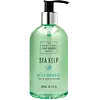What's inside
What's inside
 Key Ingredients
Key Ingredients

No key ingredients
 Benefits
Benefits

 Concerns
Concerns

 Ingredients Side-by-side
Ingredients Side-by-side

Water
Skin ConditioningSodium Laureth Sulfate
CleansingSodium Chloride
MaskingParfum
MaskingCocamidopropyl Betaine
CleansingTetrasodium Glutamate Diacetate
Propylene Glycol
HumectantPEG-120 Methyl Glucose Trioleate
CleansingSodium Benzoate
MaskingPotassium Sorbate
PreservativeGlycerin
HumectantPolyquaternium-10
Fucus Vesiculosus Extract
EmollientLaminaria Digitata Extract
Skin ProtectingBenzyl Salicylate
PerfumingHydroxycitronellal
PerfumingLinalool
PerfumingCitronellol
PerfumingCI 19140
Cosmetic ColorantCI 42090
Cosmetic ColorantWater, Sodium Laureth Sulfate, Sodium Chloride, Parfum, Cocamidopropyl Betaine, Tetrasodium Glutamate Diacetate, Propylene Glycol, PEG-120 Methyl Glucose Trioleate, Sodium Benzoate, Potassium Sorbate, Glycerin, Polyquaternium-10, Fucus Vesiculosus Extract, Laminaria Digitata Extract, Benzyl Salicylate, Hydroxycitronellal, Linalool, Citronellol, CI 19140, CI 42090
Cocamidopropyl Hydroxysultaine
CleansingSodium Cocoyl Sarcosinate
CleansingCoco-Betaine
CleansingSodium Laureth Sulfate
CleansingSodium Chloride
MaskingAloe Barbadensis Leaf Extract
EmollientAvena Sativa Kernel Extract
AbrasiveAlgae Extract
EmollientSesamum Indicum Seed Oil
EmollientMedicago Sativa Seed Powder
Skin ConditioningHelianthus Annuus Seedcake
AbrasivePrunus Amygdalus Dulcis Seed Meal
AbrasiveEucalyptus Globulus Leaf Oil
PerfumingSodium Gluconate
Skin ConditioningCopper Gluconate
Skin ConditioningCalcium Gluconate
HumectantMagnesium Gluconate
Skin ConditioningZinc Gluconate
Skin ConditioningTocopheryl Succinate
AntioxidantNiacin
SmoothingSesamum Indicum Seed Powder
Skin ConditioningButylene Glycol
HumectantSucrose
HumectantCaprylyl Glycol
EmollientSodium Bicarbonate
AbrasiveTourmaline
Hexylene Glycol
EmulsifyingParfum
MaskingEDTA
Disodium EDTA
Methylchloroisothiazolinone
PreservativeMethylisothiazolinone
PreservativePhenoxyethanol
PreservativeAlpha-Isomethyl Ionone
PerfumingGeraniol
PerfumingButylphenyl Methylpropional
PerfumingLinalool
PerfumingCI 61570
Cosmetic ColorantCI 19140
Cosmetic ColorantCocamidopropyl Hydroxysultaine, Sodium Cocoyl Sarcosinate, Coco-Betaine, Sodium Laureth Sulfate, Sodium Chloride, Aloe Barbadensis Leaf Extract, Avena Sativa Kernel Extract, Algae Extract, Sesamum Indicum Seed Oil, Medicago Sativa Seed Powder, Helianthus Annuus Seedcake, Prunus Amygdalus Dulcis Seed Meal, Eucalyptus Globulus Leaf Oil, Sodium Gluconate, Copper Gluconate, Calcium Gluconate, Magnesium Gluconate, Zinc Gluconate, Tocopheryl Succinate, Niacin, Sesamum Indicum Seed Powder, Butylene Glycol, Sucrose, Caprylyl Glycol, Sodium Bicarbonate, Tourmaline, Hexylene Glycol, Parfum, EDTA, Disodium EDTA, Methylchloroisothiazolinone, Methylisothiazolinone, Phenoxyethanol, Alpha-Isomethyl Ionone, Geraniol, Butylphenyl Methylpropional, Linalool, CI 61570, CI 19140
 Reviews
Reviews

Ingredients Explained
These ingredients are found in both products.
Ingredients higher up in an ingredient list are typically present in a larger amount.
CI 19140 is also known as Tartrazine. Tartrazine is a synthetic dye used in cosmetics, foods, and medicine to add a yellow color.
Tartrazine is created from petroleum and is water-soluble.
Some people may experience allergies from this dye, especially asthmatics and those with an aspirin intolerance.
Learn more about CI 19140Linalool is a fragrance and helps add scent to products. It's derived from common plants such as cinnamon, mint, citrus, and lavender.
Like Limonene, this ingredient oxidizes when exposed to air. Oxidized linalool can cause allergies and skin sensitivity.
This ingredient has a scent that is floral, spicy tropical, and citrus-like.
Learn more about LinaloolParfum is a catch-all term for an ingredient or more that is used to give a scent to products.
Also called "fragrance", this ingredient can be a blend of hundreds of chemicals or plant oils. This means every product with "fragrance" or "parfum" in the ingredients list is a different mixture.
For instance, Habanolide is a proprietary trade name for a specific aroma chemical. When used as a fragrance ingredient in cosmetics, most aroma chemicals fall under the broad labeling category of “FRAGRANCE” or “PARFUM” according to EU and US regulations.
The term 'parfum' or 'fragrance' is not regulated in many countries. In many cases, it is up to the brand to define this term.
For instance, many brands choose to label themselves as "fragrance-free" because they are not using synthetic fragrances. However, their products may still contain ingredients such as essential oils that are considered a fragrance by INCI standards.
One example is Calendula flower extract. Calendula is an essential oil that still imparts a scent or 'fragrance'.
Depending on the blend, the ingredients in the mixture can cause allergies and sensitivities on the skin. Some ingredients that are known EU allergens include linalool and citronellol.
Parfum can also be used to mask or cover an unpleasant scent.
The bottom line is: not all fragrances/parfum/ingredients are created equally. If you are worried about fragrances, we recommend taking a closer look at an ingredient. And of course, we always recommend speaking with a professional.
Learn more about ParfumChances are, you eat sodium chloride every day. Sodium Chloride is also known as table salt.
This ingredient has many purposes in skincare: thickener, emulsifier, and exfoliator.
You'll most likely find this ingredient in cleansers where it is used to create a gel-like texture. As an emulsifier, it also prevents ingredients from separating.
There is much debate on whether this ingredient is comedogenic. The short answer - comedogenic ratings don't tell the whole story. Learn more about comegodenic ratings here.
The concensus about this ingredient causing acne seems to be divided. Research is needed to understand if this ingredient does cause acne.
Scrubs may use salt as the primary exfoliating ingredient.
Learn more about Sodium ChlorideSodium Laureth Sulfate (SLES) is a foaming, cleansing, and emulsifying ingredient. It is created from palm kernel oil or coconut oil. SLES is not the same as sodium lauryl sulfate. It is much milder and less likely to irritate.
SLES helps create foam in personal products. It also prevents ingredients from separating, helping to elongate the shelf life.
Sodium Laureth Sulfate is a type of sulfate. It can be drying. We recommend speaking with a professional about using this ingredient if you have concerns.
Learn more about Sodium Laureth Sulfate